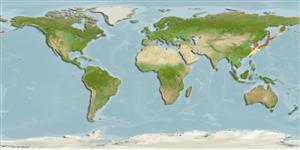>
Perciformes/Cottoidei (Sculpins) >
Liparidae (Snailfishes)
Etymology: Liparis: Greek, liparos = fat (Ref. 45335).
Eponymy: Alexander Emanuel Rodolphe Agassiz (1835–1910) was born in Switzerland but emigrated to the USA with his eminent palaeontologist father, Louis Agassiz (see next entry), and made a fortune out of copper mining. [...] (Ref. 128868), visit book page.
Environment: milieu / climate zone / Tiefenbereich / distribution range
Ökologie
seewasser demersal; tiefenbereich 0 - 100 m (Ref. 58496). Temperate
North Pacific: Iwate Prefecture to Hokkaido, in the Peter the Great Bay, the coast of Primorskiy, the western and southeastern coast of Sakhalin and southern Kuril Islands.
Length at first maturity / Size / Gewicht / Alter
Geschlechtsreife: Lm 29.0, range 28 - 30 cm
Max length : 44.0 cm TL Männchen/unbestimmt; (Ref. 56527)
Rückenflossenstacheln (insgesamt) : 0; Rückenflossenweichstrahlen (insgesamt) : 40 - 44; Afterflossenstacheln: 0; Afterflossenweichstrahlen: 32 - 35; Wirbelzahl: 45 - 48. Dorsal fin deeply notched in mature males, and unnotched or shallowly notched in mature females; pectoral fin shallowly notched, notch more prominent in smaller specimens than in larger ones, and unnotched in the largest specimen (HUMZ 89888); caudal fin broad, its posterior margin rounded and dorsal and ventral notches usually present (Ref. 28160). Disk large, located almost between verticals through posterior margin of eye and gill opening (Ref. 28160). Body brown, gray or blackish; four basic patterns present - striped, speckled, mottled and plain; dorsal and anal fins with the same color pattern as body, with dark bars or entirely blackish; caudal fin with two dark bars; eye silvery (Ref. 28160).
Body shape (shape guide): elongated.
Minimum depth reported at 0 m (Ref. 28160).
Life cycle and mating behavior
Geschlechtsreife | Fortpflanzung | Ablaichen | Eier | Fecundity | Larven
Kido, K., 1988. Phylogeny of the family Liparididae, with the taxonomy of the species found around Japan. Mem. Fac. Fish. Hokkaido Univ. (35)2:125-256. (Ref. 28160)
IUCN Rote Liste Status (Ref. 130435: Version 2025-1)
Bedrohung für Menschen
Harmless
Nutzung durch Menschen
Fischereien: nicht kommerziell
Tools
Zusatzinformationen
Download XML
Internet Quellen
Estimates based on models
Preferred temperature (Ref.
123201): 1.6 - 17, mean 8.6 °C (based on 82 cells).
Phylogenetic diversity index (Ref.
82804): PD
50 = 0.5000 [Uniqueness, from 0.5 = low to 2.0 = high].
Bayesian length-weight: a=0.00525 (0.00237 - 0.01161), b=3.15 (2.96 - 3.34), in cm total length, based on LWR estimates for this (Sub)family-body shape (Ref.
93245).
Trophic level (Ref.
69278): 3.7 ±0.6 se; based on size and trophs of closest relatives
Widerstandsfähigkeit (Ref.
120179): mittel, Verdopplung der Population dauert 1,4 - 4,4 Jahre. (Preliminary K or Fecundity.).
Fishing Vulnerability (Ref.
59153): Low to moderate vulnerability (34 of 100).
🛈
